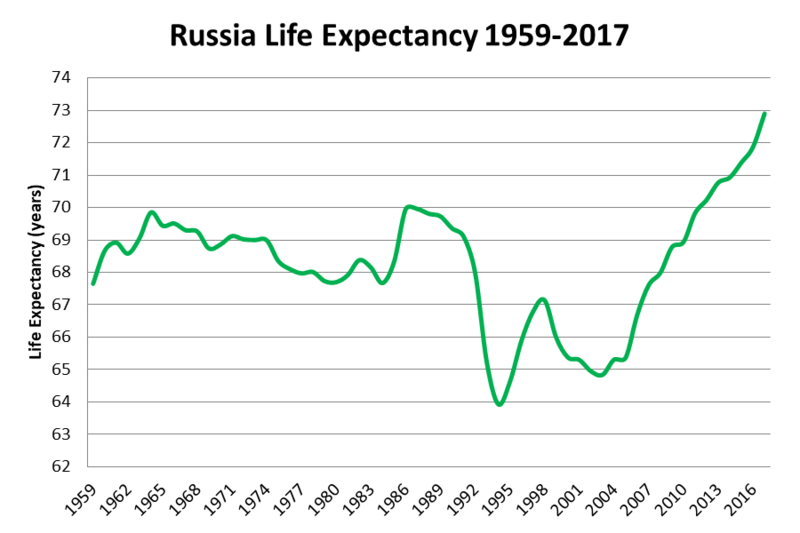Читаю статью в JAMA (по-на водке), у них пару-тройку лет падает продолжительность жизни при рождении. Статистику они пока не засекретили, но: кто знает?
Когда был маленьким, приблизительно в начале их ряда, слвшал от родителя:как родитель мой ломал храм Христа-Спасителя что мы скоро обгоним США по этому показателю, тогда модно было гоняться. Но. Не получилось. Теперь, когда мы немного поотстали, они сами не очень быстро бегут.
и ещё один, просто понравился из статьи про пенсию, но он обрезан пораньше
Когда был маленьким, приблизительно в начале их ряда, слвшал от родителя:
И вот опять
Собственно США — чорная линия, это второй рисунок (первый из вики).и ещё один, просто понравился из статьи про пенсию, но он обрезан пораньше



10 comments:
The National Center for Health Statistics reported that US life expectancy peaked (78.9 years) in 2014 and subsequently decreased significantly for 3 consecutive years, reaching 78.6 years in 2017.
По Росстату в 2018 оба пола, мужчины, потом женщины, по три значения: всё население, город, село: 72.91 67.75 77.82 73.34 68.11 78.09 71.67 66.75 76.93
Чем больше читаю, тем больше понимаю, что структура причин смерти — совсем не структура причин смерти, и смерть от старости, или по Чехову объективнее, чем какая-то гипертензия.
Although an extensive literature links health to education, wealth, and employment, direct evidence of their association with changes in life expectancy or mortality is limited, hampered by limited data to link deaths and socioeconomic history at the individual level. A growing body of evidence, however, indicates that the decline in US life expectancy and mortality risks have been greater among individuals with limited education (eg, less than high school) and income. The gradient in life expectancy based on income has also widened over time,68 with outcomes at the lower end of the distribution explaining much of the US disadvantage relative to other countries.
a multivariate analysis of drug-related mortality in 2006-2015 found that drug deaths were higher in counties with certain demographic characteristics (eg, older adults, active duty military or veterans, Native Americans) and in counties with mining-dependent economies, high economic and family distress indices, vacant housing, or high rent. Mortality rates were lower in counties with more religious establishments, recent in-migrants, and dependence on public sector (ie, government) employment.
Любопытно, что СПИД даже не упоминается в качестве причины роста, хотя кино было с Джулией Робертс и всякие другие страшылки
и Спрингстин песенку спел
и вот:
The National Research Council examined the US health disadvantage in detail and identified 9 domains in which the United States had poorer health outcomes than other high-income countries: these included not only drug-related deaths but also adverse birth outcomes, injuries and homicides, adolescent pregnancy and sexually transmitted infections, HIV and AIDS, obesity and diabetes, heart disease, chronic lung disease, and disability.
Fenelon, whose research quantified the contribution of smoking to mortality, also noted that smoking may “represent one critical piece of a broader cultural, socioeconomic, and behavioral puzzle that has implications for numerous health-related behaviors and outcomes.”
Fenelon A. Geographic divergence in mortality in the United States. Popul Dev Rev. 2013;39(4):611-634. doi:10.1111/j.1728-4457.2013.00630.x
вот это верно:
Any theory for decreasing life expectancy—whether related to opioids, despair, poverty, or social division—must account for the timing of exposure and lagged effects on outcomes.
Other limitations include the weak statistical power of annual state mortality rates and their inability to account for substate variation, the limits of age adjustment, age-aggregation bias, and the omission of cause-specific mortality data from before 1999.
...
state mortality rates may also reflect demographic changes, such as immigration patterns (and the immigrant paradox) or the out-migration of highly educated, healthy individuals.
Post a Comment